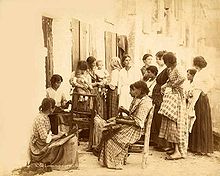Women's work
Today, women's work in the narrower sense means the employment of women, furthermore all tasks ( e.g. child care , assistance in the family business), which women are assigned through a social role , as well as the engagement in the area of advocacy , education and so on for the benefit of women . See also: Gender and Gender Mainstreaming . The women's movement of the 1970s drew attention to the fact that housework is also a form of work ( paid through the maintenance obligation). A better work-life balance was and is demanded and promoted from many sides. Furthermore, care work is a much-discussed variant, mainly carried out by women in the context of care work.
history

The proportion of women working for wages increased during the period of industrialization and thus made them a subject of social issues , in particular the issue of working conditions, occupational health and safety and fair wages. Finally, the women's movement, which campaigned for women's rights, came into being.
Advocates of improving the situation of women in working life include Louise Otto-Peters (1819–1895), Peter Norrenberg (1847–1898) and Iris von Roten (1917–1990).
In France there was a republican alliance under Prime Minister Pierre Waldeck-Rousseau from 1899 to 1902 , which legally limited the daily working time to eleven hours and also regulated women's and child labor .
According to the 1907 “occupational census”, 28% of adult women in the German Reich were employed outside the private household. Three million women worked in other households, 400,000 in industry, trade and transport. Of the 400,000, 43,953 were “home workers”, 34,000 were launderers, 37,000 seamstresses and 22,000 seamstresses.
During the Second World War there was a sharp increase in the employment rate of women .
Reforms of the 1960s and 1970s
In the German Democratic Republic , the family law from 1966 required that the spouses organize their relationship in such a way “that the woman can reconcile her professional and social activities with motherhood”.
In Austria , the family law reform in 1975 largely equated men and women , and gender-specific assignments were reduced.
In the Federal Republic of Germany from 1958 to 1977 the division of labor between the married couple was regulated by Section 1356 of the German Civil Code (BGB), paragraph 1: “[1] The wife runs the household on her own responsibility. [2] She is entitled to be gainfully employed insofar as this is compatible with her duties in marriage and family. ”In 1970 a commission of experts submitted proposals for a comprehensive reform of marriage and family law. Due to the premature dissolution of the Bundestag in 1972 , a first draft was not discussed in the Bundestag until 1973. The deliberations dragged on until 1976; on June 14, 1976 the new law was promulgated. It came into force on July 1, 1977. One speaks of the "equal husband model". Section 1356 of the German Civil Code reads: “The spouses regulate household management by mutual agreement. [...] Both spouses are entitled to be gainfully employed. "
Current situation
In Europe today, more women than men are employed part-time , 72% (see polarization of working hours ). In 1997, female unemployment was mostly higher than average.
Differences between the pay of men and women are addressed as the gender pay gap . In the years after the war, women received up to 40% less wages than men in a comparable position; “wage reduction clauses” for “women's wage groups” were created and applied. In 1955 the Federal Labor Court ruled that underpaid women contradicted the principle of equality of the Basic Law ; this also applies to gainful employment. This must be observed nationwide in the collective agreements between companies and unions . Later, however, so-called low wage groups were implemented, largely relating to the work of women. Today, gender pay differentials are analyzed and evaluated, particularly with reference to gender mainstreaming in the field of job evaluation.
The gender researcher Cornelia Koppetsch wrote in 2001 on the professional differences between men and women: A look at “gender discrimination” falls short of understanding the significance of gender differences for professional development, since it only applies the phenomenon of gender segmentation to one category of actors search back. "Individual women are not excluded from high positions; rather, the criteria of professional excellence are themselves gendered because they create a close connection between desired abilities, behavioral styles and 'qualifications' with cultural definitions of masculinity and (less often) femininity."
See also
- Housewifeization
- Foreign domestic help
- Maid
- Women's rights
- Women's studies in the German-speaking area
- Female employment rate
- List of proportions of women in the professional world
- Proletarian women's movement
- UN Convention on the Elimination of All Forms of Discrimination against Women
literature
- Gisela Bock , Barbara Duden : Work out of love - love as work. On the origin of housework in capitalism. In: Annemarie Tröger (Ed.): Women and Science. Contributions to the Berlin Summer University for Women, July 1976. Courage-Verlag, Berlin 1977, ISBN 3-921710-00-6 .
- Angela Fiedler and Ulla Regenhard: The Labor Income of Women. Analysis of discrimination in the labor market. BWV Berliner Wissenschafts-Verlag, Berlin 1987, ISBN 3-87061-917-1 .
- Birgit Geissler , Friederike Maier, Birgit Pfau-Effinger (eds.): FrauenArarbeitsMarkt. The contribution of women's studies to socio-economic theory development. Edition sigma, Berlin 1998, ISBN 3-89404-626-0 .
- Karin Hausen : The polarization of the "gender characters". A reflection of the dissociation of work and family life. In: Werner Conze (Ed.): Social history of the family in modern times in Europe. Klett, Stuttgart 1976, pp. 367-393, ISBN 3-12-910390-2 (Industrielle Welt; 21).
- Karin Hausen: Gender hierarchy and division of labor. On the history of unequal employment opportunities for men and women. Vandenhoeck & Ruprecht, Göttingen 2001, ISBN 3-525-01353-1 (Vandenhoeck collection).
- Angélique Janssens: The male breadwinner. On the story of a symbolic social figure. In: Yearbook for Research on the History of the Labor Movement , Issue I / 2002.
- Alice Salomon : The causes of the unequal pay for men and women. Verlag Schmidt Periodicals, Bad Feilnbach 1990 (reprint of the Leipzig, Duncker & Humblot edition, 1906).
- Claudia von Werlhof : Women's work. The blind spot in the criticism of political economy. In: contributions to feminist theory and practice. Issue 1, Munich 1978.
- Dagmar Vinz: Times of Sustainability. Perspectives for an ecological and gender-equitable time policy. Westfälisches Dampfboot, Münster 2005, ISBN 3-89691-613-0 (Chapter 8 on the feminization of employment in the food system).
Web links
- Women's work in the First World War Pictures from the image archive of the LWL media center for Westphalia
Individual evidence
- ↑ On women's work in factories in the 19th century, cf. Collection of sources on the history of German social policy from 1867 to 1914 , Section I: From the time when the Reich was founded to the Imperial Social Message (1867-1881), Volume 3: Workers' protection ; edited by Wolfgang Ayaß , Stuttgart / Jena / New York 1996; Collection of sources on the history of German social policy from 1867 to 1914, Section II: From the Imperial Social Message to the February decrees of Wilhelm II (1881-1890), Volume 3: Workers' protection, edited by Wolfgang Ayaß, Darmstadt 1998; Collection of sources on the history of German social policy from 1867 to 1914, III. Department: Expansion and differentiation of social policy since the beginning of the New Course (1890-1904), Volume 3, worker protection, edited by Wolfgang Ayaß, Darmstadt 2005.
- ↑ See: Modification of the service regulations for women admitted to the barrier service (Eisenbahndirektion Mainz (Hrsg.): Collection of the published official gazettes of April 27, 1901. Volume 5, No. 18, Announcement No. 182, p. 115).
- ^ Elsbeth Krukenberg-Conze, in: Das Frauenbuch , Franck, Stuttgart 1913
- ↑ [1]
- ↑ Elena Marinucci: Report on the special effects of women's unemployment. , 1998 (pdf) ( Memento of the original from September 26, 2007 in the Internet Archive ) Info: The archive link has been inserted automatically and has not yet been checked. Please check the original and archive link according to the instructions and then remove this notice.
- ↑ Cornelia Koppetsch: Milieu and gender. A context-specific perspective . Published in Anja Weiß et al. (Ed.): Class and Classification. The symbolic dimension of social inequality . Westdeutscher Verlag 2001, pp. 109-137. P. 112


